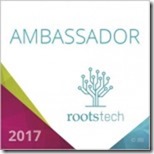#RootsTech 2017 Ambassadors - Wed, 7 Dec 2016
I haven’t seen a list of 2017 Roots Tech Ambassadors anywhere. So here’s the people I’ve found:
 Alison Taylor, USA – Pictures and Stories
Alison Taylor, USA – Pictures and Stories - Allison Kimball, USA – Simple Inspiration
- Amy Archibald, USA – Revealing Roots and Branches (Ambassador Coordinator)
- Amy Johnson Crow, USA – Professional Genealogy Services
- Amy Lenertz, USA – Raincross Information Services
- The Ancestry Insider, USA
- Angela Crookston – The Real Housewives of Riverton
- Bernice Bennett, USA – Genealogy Live Talk Radio
- Beverly A Harper, USA – Mississippi Ancestors
- Brandi Jeter Riley, USA – Mama Knows It All
- Carissa Rasmussen, USA – Family History modernized
- Carol Rice, USA – Family Storytelling
- Cheri Hudson Passey, USA – Carolina Girl Genealogy
- Christine Woodcock, Canada – Scottish Genealogy Tips and Tidbits
- Dave Dowell, USA – Dr D Digs Up Ancestors
- David Allen Lambert, USA – ExtremeGenes
- Diana Elder, USA – The Family Locket Blog
- Helen Smith, Australia – From Helen V Smith’s Keyboard
- James Tanner, USA – Genealogy’s Star
- Jana Greenhalgh, USA – The Genealogy Kids
- Jen Baldwin, USA – ConferenceKeeper.org
- Jenn Crookston– The Real Housewives of Riverton
- Jennie Fairs, Australia – Family Leaves and Branches
- Jennifer Alford, USA – Jenealogy
- Jessica Taylor, USA – The Legacy Tree Genealogists Blog
- Jenny Joyce, Australia – Jennyalogy
- Jill Ball, Australia – GeniAus
- Judy G. Russell, USA – The Legal Genealogist
- Katherine R. Willson, USA – Social Media Genealogy
- Kathryn Lake Hogan, Canada – Looking 4 Ancestors
- Kirsty Gray – GB – Family Wise Ltd
- Lara Diamond, USA – Lara’s Jewnealogy
- Laura Hedgecock, USA – Treasure Chest of Memories
- Laurie Conklin, USA – Sharing The Past
- Lynn Broderick, USA – The SIngle Leaf
- Marie Cappart, Belgium – Histoires de Familles – Families Stories
- Melynda Valgardson Fanene, USA – Every Second in Life is Precious
- Michelle Goodrum, USA – The Turning of Generations
- Nichole Dyer, USA – The Family Locket Blog
- Paula Iniguez – The Real Housewives of Riverton
- Pat Richley-Erickson - Dear Myrtle, USA
- Peggy Lauritzen, USA – Telling my family’s history
- Rachel LaCour Niesen, USA – Save Family Photos
- Randy Seaver, USA – Genea-Musings
- Renee Zamora, USA – Renee’s Genealogy Blog
- Richard Young, USA – Family History Tech
- Robin Foster, USA – Saving Stories
- Ruby Baird, USA – Ruby’s Genealogy Ramblings
- Ruth Blair, Canada – The Passionate Genealogist
- Shannon Combs-Bennett, USA – Trials and Tribulations of a Self-Taught Family HIstorian
- Sunny Morton, USA – Writer for Lisa Louise Cooke’s Genealogy Gemss
- Tami Osmer Mize, USA – Relatively Curious
- Terri O’Connell, USA – Finding Our Ancestors
- Thomas MacEntee, USA – GeneaBloggers
- Timo Kracke, Germany – Familienforschung fur die Ohren
- Toni Carrier, USA – Lowcountry Africana
- Valerie Elkins, USA - Family Cherished
- Wesley Eames, USA – Ancestor Cloud Blog
If I got any wrong or I missed anybody, let me know and I’ll update the list.
I’m pleased to say that I know or have met at least a third of the people listed, including several of those from Australia. I look forward to seeing them again and meeting some of those I haven’t met yet in February at RootsTech 2017.
Update: January 17, 2007: I checked my list against the list the Ancestry Insider provided of 46 who registered to have their social media information shared. I added 10 from this list who I didn’t have.




 Feedspot 100 Best Genealogy Blogs
Feedspot 100 Best Genealogy Blogs





